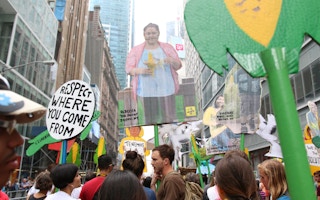The United States has generated more heat-trapping carbon pollution than any other nation, but it has not felt the impact of climate change in equal measure.
Poorer countries in warmer latitudes are enduring the most devastating droughts, heatwaves, and violent storms, and seeing more poverty, disease and mass migration as a result. By doing so much to fuel climate change, the United States has incurred a massive debt to the developing world, and there is no easy way to pay down the balance.
President Biden is trying, but in a country that is largely opposed to more foreign assistance, he faces significant hurdles to ramping up aid. He recently promised to spend $5.7 billion a year to help developing countries cope with climate change, but that sum is far from sufficient, as critics were quick to point out.
The White House, however, is also exploring other, less direct means of providing relief. Among them, a major change to immigration policy that could give a measurable boost to countries hard hit by climate disasters.
Biden recently directed his national security adviser to study ways to resettle people displaced by climate change, while Democrats in Congress introduced a bill that would create a pathway for climate migrants to make a new home in the United States.
Such protections would not only benefit the migrants themselves, but also the countries they left behind. By relocating to wealthier countries in cooler regions, migrants have the opportunity to make more money and to send a portion of their paycheck to family back home. Research shows that, through remittances, they can help people in developing countries better navigate the fallout from climate disasters.
For a 2018 study, researchers at the University of Ghana asked locals how they were using remittances to cope with climate change. Fishers facing diminishing fish stocks used remittances to buy new nets and repair canoes, while growers coping with less predictable rainfall built water tanks and purchased fertiliser.
One man used the money his nephew sent him to buy a cell phone so he could get weather updates and know when to plant his crops. Another used money his son sent him to make small loans to cashew farmers, allowing him to help local growers while turning a small profit. The findings, authors wrote, “should provoke a new global debate on climate refugees.”
By making regular cash transfers, climate migrants can provide relatives with a basic income, allowing them to pay for food, shelter and medical care, even in the midst of a disaster or an economic downturn. Migrants can also directly fund projects to guard against climate change, such as new wells to help farmers cope with droughts, or levees to protect against floods.
A recent study from Princeton University modelled future migration in a world with more open borders and a world with closed borders to compare the movement of people and the flow of remittances.
Predictably, they found that in a world with more open borders more people would migrate from Africa, Asia, Central America and the Pacific to Europe and the United States to escape climate change. The effect of the resulting remittances would be profound.
While climate change is expected to stunt GDP in developing countries, allowing people to move more freely around the world would soften the blow. The study determined that more open borders could boost GDP per capita in Central America and Southeast Asia by more than 2 per cent as migrants wire money home.
Of course, remittances are far from a perfect, or even sufficient, means of helping poorer countries cope with climate disasters. So long as climate migrants are sending money home, they will have to work harder to build wealth in their adoptive countries. They will, in effect, continue to bear the burden of climate change. But given that climate migration is inevitable — and already underway — remittances are just one more reason to allow people uprooted by disasters to immigrate to the United States.
By 2050, climate change could dislocate as many as 3.9 million people in Mexico and Central America. In a new white paper on migration from Central America, experts from Harvard Law School, Yale Law School and the University Network for Human Rights call on lawmakers to create a temporary visa for people displaced by climate change, and that visa could offer a pathway to a green card or citizenship. Biden could champion this model.
Politically, such a move would be difficult. On few other issues are Democrats and Republicans more divided than on climate change and immigration. Republicans are highly sceptical, to put it mildly, of both. Making it easier for climate migrants to move to the United States would likely spark harsh Republican opposition. And in an era of negative partisanship, Democrats’ success in the 2022 midterm elections may depend less on mobilising friendly voters than on not giving Republicans a reason to head to the polls.
At the same time, Biden has promised to take a government-wide approach to the climate crisis. That means using every available lever of power to tackle the issue, including updating immigration policy. Crucially, by offering refuge to climate migrants, he would be able to reassert US leadership on a key issue.
A UN panel ruled last year that countries cannot deport refugees who are facing immediate threats from climate change in their home country, but the ruling is nonbinding, and it’s not clear who should be counted as a climate refugee. The question is so thorny that, currently, no country offers formal protections to people displaced by climate change.
The United States could be the first, creating a model for other wealthy nations to follow. Doing so would likely be administratively challenging and politically costly, but it would also go some way to settling America’s climate debt.
This story was published with permission from Nexus Media.









